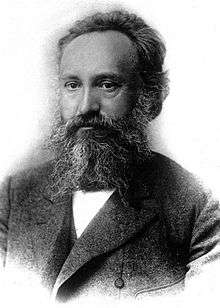Evgraf Fedorov
| Evgraf Fedorov | |
|---|---|
 Evgraf Stepanovich Fedorov | |
| Born |
22 December 1853 Orenburg |
| Died |
21 May 1919 (aged 65) Petrograd, RSFSR |
Evgraf Stepanovich Fedorov (Russian: Евгра́ф Степа́нович Фёдоров, 22 December 1853 – 21 May 1919) was a Russian mathematician, crystallographer and mineralogist.[1][2][3]
Fedorov was born in the Russian city of Orenburg into a family of engineers. The family later moved to Saint Petersburg. From the age of fifteen he was deeply interested in the theory of polytopes, which later became his main research interest. He was a distinguished graduate of the Gorny Institute, which he joined at the age of 26.
He contributed to the identification of conditions under which a group of Euclidean motions must have a translational subgroup whose vectors span the Euclidean space. His best-known result is his 1891 proof concerns the Wallpaper group, showing that there are only 17 possible tilings of the plane[4] and then derived independently by George Pólya in 1924.[5] The proof that the list of wallpaper groups was complete only came after the much harder case of space groups had been done. In 1895, he became a professor of geology at the Moscow Agricultural Institute (now the Timiryazev Academy). Fedorov died from pneumonia in 1919 during the Russian Civil War in Petrograd, RSFSR.
Publications
- His first book, "Basics of Polytopes", was finished in 1879 and published in 1885. It offers a classification of polytopes and derives Fedorov polytopes, congruent polytopes that can completely fill space.
- He wrote the classic "The symmetry of regular systems of figures" in 1891,[6] which contained the first cataloging of the 230 space groups. The same year the equivalent results were presented by German mathematician Schönflies. Fedorov and Schönflies had been intensively discussing the subject during their work, so the results can be somehow considered as joint ones, though Schönflies noted Fedorov priority for some major ideas.
- He published his classic work "The theodolite method in mineralogy and petrography" in 1893.[7]
See also
References
- ↑ I. I. Shafranovskii and N. V. Belov, "In Memoriam: E. S. Fedorov 1853–1919," in P. P. Ewald, ed., Fifty Years of X-ray Diffraction (Utrecht, Nederland: International Union of Crystallography, 1962), pages 341–350. PDF online
- ↑ R.V. Galiulin (November 2003) "To the 150th anniversary of the birth of Evgraf Stepanovich Federov (1853–1919): Irregularities in the fate of the theory of regularity," Crystallography Reports, vol. 48, no. 6, pages 899–913. PDF online
- ↑ A. Meniailov, "Fyodorov (or Fedorov), Evgraf Stepanovich" in Charles C. Gillispie, editor in chief, Dictionary of Scientific Biography (New York, New York: Charles Scribner's Sons, 1972), vol. 5, pages 210–214.
- ↑ E. Fedorov (1891) "Simmetrija na ploskosti" [Symmetry in the plane], Zapiski Imperatorskogo Sant-Petersburgskogo Mineralogicheskogo Obshchestva [Proceedings of the Imperial St. Petersburg Mineralogical Society], series 2, vol. 28, pages 245-291 (in Russian).
- ↑ George Pólya (1924) "Über die Analogie der Kristallsymmetrie in der Ebene," Zeitschrift für Kristallographie, vol. 60, pages 278–282.
- ↑ E. S. Fedorov (1891) "Симмтрія правильныхъ системъ фигуръ" ("Simmetriia pravil'nykh sistem figur") [The symmetry of regular systems of figures], Zapiski Imperatorskogo S. Petersburgskogo Mineralogichesgo Obshchestva [Proceedings of the Imperial St. Petersburg Mineralogical Society], series 2, vol. 28, pages 1–146. English translation: David and Katherine Harker (trans.), Symmetry of Crystals, American Crystallographic Association Monograph No. 7 [Bufallo, N.Y.: American Crystallographic Association, 1971], pages 50–131.
- ↑ Kunz, George Frederick and Wherry, Edgar T. (3 June 1921) "Russian Geologists" Science New Series 53(1379): pp. 516–517
External links
| Wikimedia Commons has media related to Evgraf Fedorov. |
- Fedorov session 2010.
- Fedorov session 2008.
- Fedorov session 2006.
- Small universal stage after Federow for mineralogical microscopy, Berlin approx. 1900
- Universal stage after Federow for mineralogical microscopy, Berlin approx. 1925
- Large microscope after Brandão-Leiß with integrated universal stage after Fedorow, Berlin approx. 1925
- (Russian) Brief Biography
|